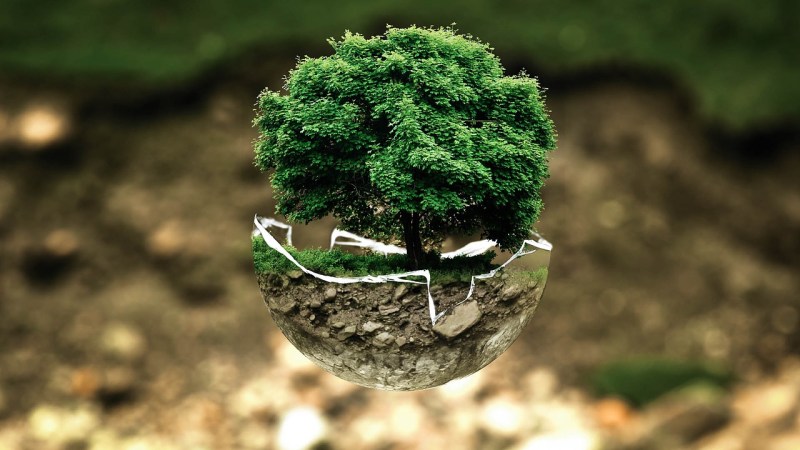
Life is undoubtedly hectic, and sometimes just dealing with work and life is a feat in and of itself. And with the whirlwind that is life, convenience occasionally (and understandably) trumps being mindful of our carbon footprints.
To boot, sometimes it feels like, as one person, there’s not much you can do to really go green and lower your carbon footprint, save for completely going off-grid and becoming a die-hard vegan. But it’s not as hard as you might think to make changes to your day-to-day life and help take some pressure off the planet.
We talked to Joe Lamp’l, the host of the PBS show Growing A Greener World, about how to go green–both at work and at home–without totally going off the grid.
Start Small
We’re not here to tell you to change your entire life overnight. In fact, though radical change can work for some people, studies show that incremental change has a higher likelihood of sticking.
And hey, making small changes is better than doing nothing. This idea that you’re just one person, and you can’t do much to change the way things are going? Well, Lamp’l says “just one person” adds up pretty quickly. “Sure you’re one person, but you’re in a household, in a neighborhood, in a community. It all adds up.”
In fact, your behavior can affect neighbors’ behavioral patterns when it comes to things like recycling, so being just one person really does matter.
Related: 5 Great Green Brands To Buy In Celebration Of Earth Day
Love Coffee? Start There
While products of convenience certainly make our lives easier both at work and at home—K-cups, anyone?—they definitely don’t do any favors to the environment.
“I’m a passionate coffee drinker, and I love the convenience of those cups,” Lamp’l says, “but they’re just terrible.”
Lamp’l says in 2014, 9.8 billion plastic single-serve coffee cups all went into landfills. Those little plastic cups aren’t biodegradable, either. In other words: they’ll be around for millions of years. To boot, they produce methane gas, a greenhouse gas which is 20 times more potent than carbon dioxide. Yikes.
The good news? Lamp’l says you don’t have to give up your beloved single-serving coffee machine anymore. A Canadian coffee roaster, Club Coffee, recently developed a completely compostable single-serving coffee pod, Purpod100, that means you can have your coffee and drink it too.
“This isn’t just greenwashing,” Lamp’l says.
These pods are certified 100 percent compostable by the Biodegradable Products Institute, and they can be composted in your backyard or you can throw them into your municipal food waste or composting bin, because they’re suited to both individual and industrial composting. To boot, there’s no need to buy any special equipment—they can go into any single-serve coffeemaker. For now, the pods are rolling out in stores in Chicago, but you can also buy them online. Easy as pie.
Be Smart When You Eat Meat
According to Lamp’l, “A lot of the issues around the world are related to the food we eat—livestock in particular.”
Livestock—specifically, cows and pigs—account for about 18 percent of greenhouse gas emissions. They produce more methane gas (measured in carbon dioxide equivalents) than global transportation. That’s right: our beloved steak is a major contributor to greenhouse gas build-up. And as global meat consumption grows, so do the problems associated with livestock: namely, the land and water resources used to raise livestock and the methane gas produced by livestock.
We know, we know. This is The Manual: land of whiskey and steak. Are we suggesting that you go, gulp, vegetarian? We have some good news. You don’t have to stop eating meat all-together. Keep your steak knives and your iron stomach. When it comes to enjoying a hunk of cooked-to-perfection filet, you can consume smartly.
Know where your food comes from. A lot of the methane gas livestock produces comes from poor diets. Cows, for instance, basically evolved to convert grass to milk and meat. That’s what they were put on this earth for: to graze the green stuff. And yet, many mass-producers of meat feed their livestock corn- and soybean-based diets. Those diets also usually go hand-in-hand with cramped quarters and increased likelihood of getting sick. Always go for grass-fed, and whenever possible, buy local. Taking miles off your food decreases fossil fuel consumption related to food transportation.
Cut back on consumption. The average American eats more meat in a year than every other country in the world, save for Luxembourg. Cutting your meat consumption will undoubtedly help lower your carbon footprint. The European Food Information Council suggests eating lean meat once or twice a week. Wait, what? Only once or twice a week? No worries. Start slow: cut out one meat-based meal every two weeks until you’ve hit your 1-2 meals per week mark. The decrease will be so slow that you’ll hardly notice. And as a bonus? Only eating meat a handful of times a week will make it that much more special when you get around to grilling that New York strip.
Pack your own lunch. This one speaks for itself. If you pack your lunch, you’ll be less likely to go out with coworkers and indulge in that lunchtime reuben.
Extra, Extra, Read All About It
Ultimately, Lamp’l says, education is the most important aspect of going green.
“Education is the key,” Lamp’l says. “There’s a much better chance you’ll get to the second step—you know, read about it, then you’re more likely to do something.”
The amount of information out there can overwhelm, however. So Lamp’l suggests starting with your passion: what bothers you about the environment? Start from there. “You want to ask: what role can I play in fixing that?”
Instead of trying to tackle the entirety of climate change, starting small–by focusing on one aspect of a large problem–makes it more likely that you’ll be able to come up with a game plan.



